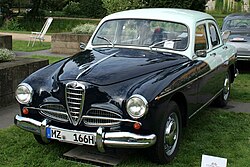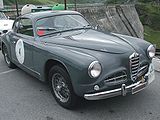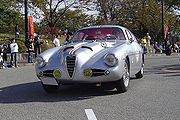Alfa Romeo 1900
 | |
| Manufacturer | Alfa Romeo |
|---|---|
| Production | 1950–1959 |
| Assembly | Portello, Milan, Italy Nessonvaux, Liege, Belgium (S.A. Imperia 1953–1954) |
| Predecessor | Alfa Romeo 6C 2500 |
| Successor | Alfa Romeo 2000 |
| Body style | sedan spider coupe |
| Layout | FR layout |
| Engine | 1.9 L DOHC I4 2.0 L DOHC I4 |
| Transmission | 4 and 5-speed manual |
| Wheelbase | Berlina/Sprint 2,630 mm (103.5 in)/2,500 mm (98.4 in) 2,500 mm (98.4 in) (1900C) |
| Length | 4,400 mm (173.2 in)/4,400 mm (173.2 in) |
| Width | 1,600 mm (63.0 in)/1,630 mm (64.2 in) |
| Height | 1,490 mm (58.7 in)/1,350 mm (53.1 in) |
| Curb weight | 900–1,100 kg (2,000–2,400 lb) |
| Related | Alfa Romeo 1900M AR51 Alfa Romeo Disco Volante IKA Bergantin |
The Alfa Romeo 1900 is a sports sedan designed by Orazio Satta for the Alfa Romeo company in 1950. It was Alfa Romeo's first car built entirely on a production line and was also Alfa's first production car without separate chassis and first Alfa offered with left-hand drive. The car was introduced first time for bigger audience in 1950 Paris Motor Show.
The 1900 was offered in two-door or four-door models, with a new 1884 cc (bore 82.55 mm, stroke 88 mm), 90 bhp, 4-cylinder twin cam engine. It was spacious and simple, yet quick and sporty. The slogan Alfa used when selling it was "The family car that wins races", not-so-subtly alluding to the car's success in the Targa Florio, Stella Alpina, and other competitions. In 1951 the short wheelbase 1900C (c for corto (Italian for short)) version was introduced. It had a wheelbase of 2,500 mm (98.4 in). In the same year the1900TI with a more powerful 100 bhp (75 kW; 101 PS) engine was introduced, it had bigger valves, a higher compression ratio and it was equipped with a double carburetor. Two years later the 1900 Super and 1900 TI Super (also 1900 Super Sprint) with 1975 cc engine were introduced (bore increased to 84.5 mm, stroke unchanged). The TI Super had two double carburetors and 115 bhp (86 kW; 117 PS). Transmission was a 4-speed manual on basic versions and 5-speed manual in Super Sprint version, the brakes were drum brakes. The 1900 had independent front suspension (double wishbones, coil springs and hydraulic telescopic shock absorbers) and live rear axle.
Production at the company's Milan plant continued until 1959: a total of 21,304 were built, including 17,390 of the saloons.
The chassis was designed specifically to allow coachbuilders to rebody it, the most notable of which was the Zagato designed, 1900 Super Sprint Coupe, with an improved engine and custom body design. The Alfa Romeo 1900M AR51 (or "Matta") is a four-wheel drive off-road vehicle based on the 1900-series.
Engines
| Model | Displacement | Power | Top speed |
|---|---|---|---|
| 1900 | 1,884 cc | 80-90 bhp | 103 mph (166 km/h)-106 mph (171 km/h) |
| TI | 1,884 cc | 100 bhp | 170 km/h (110 mph) |
| Super | 1,975 cc | 90 bhp | 160 km/h (99 mph) |
| TI Super | 1,975 cc | 115 bhp | 112 mph (180 km/h) |
IKA Bergantin
Industrias Kaiser Argentina produced between 1960 and 1962 a car named IKA Bergantin in Argentina, the body and suspension was from 1900 Berlina and engines were from Willys line, 4-L 151 cu in (2.5 L) In. and the 6-L 226 cu in (3.7 L).














![Validate my RSS feed [Valid RSS]](valid-rss-rogers.png)















































































ไม่มีความคิดเห็น:
แสดงความคิดเห็น